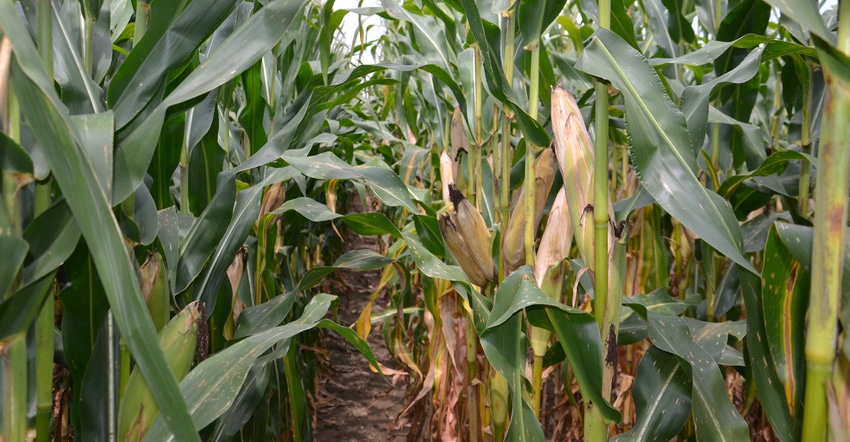
The operator who planted the Corn Watch ’18 field planted two hybrids all the way across the field. He placed one hybrid in 12 rows of his 24-row planter, and the other hybrid in the other 12 boxes. What he cares most about is yield and moisture content at harvest, because those two relate directly to profitability. However, Dave Nanda says that there are several visual differences between the hybrids.
These differences became more apparent as harvest approached. Nanda is an independent crops consultant based in Indianapolis, Ind., who visits the corn Watch ’18 field regularly during the season. Corn Watch ’18 is sponsored by Seed Genetics-Direct, Washington Court House, Ohio.
Compared to visits throughout the season, it was easiest to distinguish between the two hybrids and pinpoint the spots where rows stood side by side on Nanda’s visit in late August. In July he noted that the tassels were different, with one having more branches than the other. This time, other differences were also apparent.
Visual differences
The husks tended to be brown, indicating they might be drier, on the taller hybrid vs. the shorter hybrid. Overall, the shorter hybrid appeared to still have an overall deeper green color to its leaves. Both were showing signs of diseases, even though a fungicide was applied around pollination, and both were showing some signs of nitrogen deficiency.
“Fungicides don’t last forever,” Nanda says. “They provide coverage for two to three weeks after application, depending upon the product. That’s a key time. They did their job. By late August, lesions of gray leaf spot were on some leaves above the ear leaf on both hybrids, but the leaves were still functional.
“There was also a considerable amount of northern corn leaf blight in the field. It came in later, likely favored by cooler weather during the latter part of July that continued into August.”
Ear placement wasn’t as uniform on the taller hybrid as on the shorter one, Nanda notes. As the husks on the taller hybrid turned brown, ear placement was more obvious. Overall, ears were placed higher on the taller hybrid.
Other differences
Nanda checked the number of husks on an average ear on each hybrid. He found that the shorter hybrid tended to average 8.5 husks, while the taller hybrid had 9 husks per ear on average. Number of husks is a trait which can vary by hybrid, he observes.
While husks looked brown on the taller hybrid, when Nanda pulled ears from each, husked them and looked for black layers on kernels, kernels from the shorter hybrid with greener husks were closer to black layer than kernels from the taller hybrid. Kernels have not yet reached black layer in either hybrid. When the black layer forms, the hybrid is physiologically mature, and no more materials can enter or leave the kernel. It typically occurs at 32% to 35% moisture.
“The taller hybrid tasseled a couple days later than the earlier hybrid, so it’s not surprising that it would be slightly behind on maturity,” Nanda concludes.
About the Author(s)
You May Also Like




